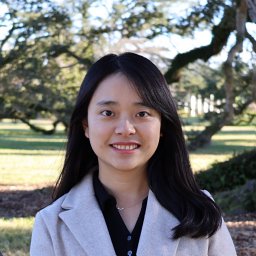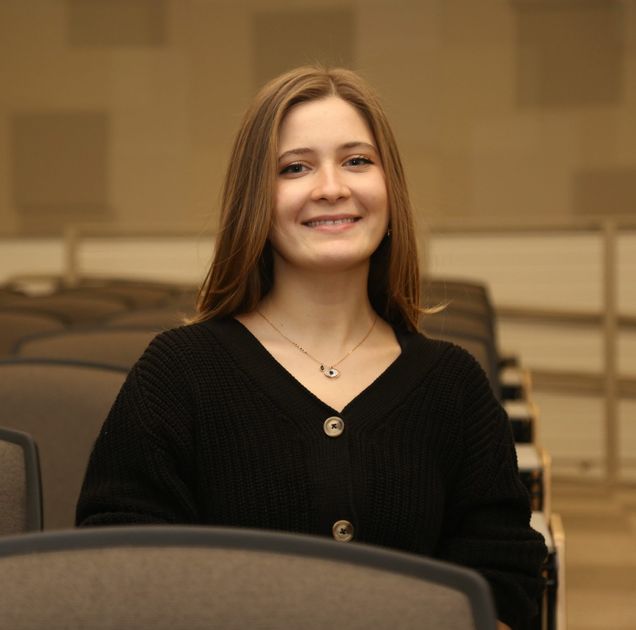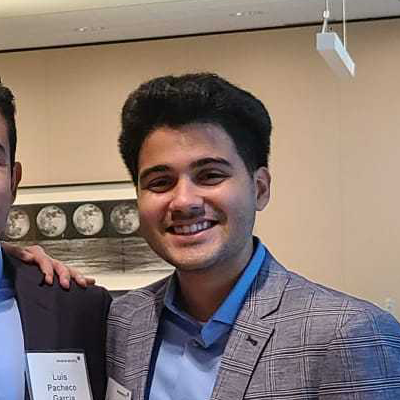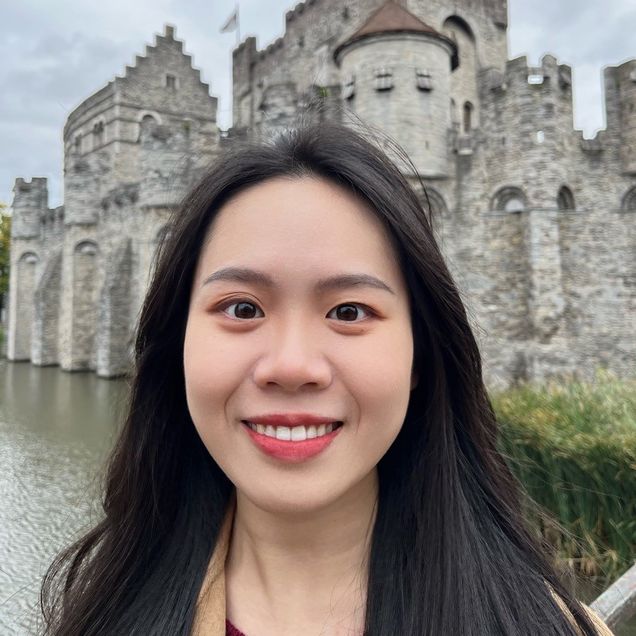CGSW 10.0 Student Research Presentation Abstracts
Session 1: Autonomous Control |
|||
| 10:30am | 10:45am |

|
Learning Robust and Correct Controllers from Signal Temporal Logic Specifications Using BarrierNet We consider the problem of learning a neural network controller for a system required to satisfy a Signal Temporal Logic (STL) specification. We exploit STL quantitative semantics to define a notion of robust satisfaction. Guaranteeing the correctness of a neural network controller is a difficult problem that received a lot of attention recently. We provide a general procedure to construct a set of trainable High Order Control Barrier Functions (HOCBFs) enforcing the satisfaction of formulas in a fragment of STL. We use the BarrierNet, implemented by a differentiable Quadratic Program (dQP) with HOCBF constraints, as the last layer of the neural network controller, to guarantee the satisfaction of the STL formulas. We train the HOCBFs together with other neural network parameters to further improve the robustness of the controller. Simulation results demonstrate that our approach ensures satisfaction and outperforms existing algorithms. |
| 10:45am | 11:00am |

|
Assessing Reputation to Improve Team Performance in Heterogeneous Multi-Robot Coverage We consider a heterogeneous multi-robot team, where robots are equipped with different capabilities to serve discrete events in an environment. We utilize a heterogeneous coverage control approach to partition the space according to robot capabilities and the estimated probability density, such that each robot is responsible for serving the events in its assigned region. As the team serves events, we assign each robot a reputation, which is then used to adjust the size of a robot’s region, thus adjusting the amount of space a robot serves. Read More |
| 11:00am | 11:15am |

|
Safe Optimal Interactions Between Automated and Human-Driven Vehicles in Mixed Traffic with Event-Triggered Control Barrier Functions This paper studies safe driving interactions between Human-Driven Vehicles (HDVs) and Connected and Automated Vehicles (CAVs) in mixed traffic where the dynamics and control policies of HDVs are unknown and hard to predict. In order to address this challenge, we employ event-triggered Control Barrier Functions (CBFs) to estimate the HDV model online, construct data-driven and state-feedback safety controllers, and transform constrained optimal control problems for CAVs into a sequence of event-triggered quadratic programs. We show that we can ensure collision-free between HDVs and CAVs and demonstrate the robustness and flexibility of our framework on different types of human drivers in lane-changing scenarios while guaranteeing safety with human-in-the-loop interactions. |
| 11:15am | 11:30am |

|
Optimal Control of Connected Automated Vehicles with Event-Triggered Control Barrier Functions: a Test Bed for Safe Optimal Merging We address the problem of safely coordinating a network of Connected and Automated Vehicles (CAVs) in conflict areas of a traffic network. Such problems can be solved through a combination of tractable optimal control problems and Control Barrier Functions (CBFs) that guarantee the satisfaction of all constraints. These solutions can be reduced to a sequence of Quadratic Programs (QPs) which are efficiently solved online over discrete time steps. However, guaranteeing the feasibility of the CBF-based QP method within each discretized time interval requires the careful selection of time steps which need to be sufficiently small. This creates computational requirements and communication rates between agents which may limit the controller’s application to real CAVs. We tackle this limitation by adopting an event-triggered control approach for CAVs such that the next QP is triggered by properly defined events with a safety guarantee. We present a laboratory-scale test bed developed to emulate merging roadways using mobile robots as CAVs. We present results to demonstrate how the event-triggered scheme is computationally efficient and can handle measurement uncertainties and noise compared to timedriven control while guaranteeing safety. |
Session 2: Systems and Hardware |
|||
| 11:45am | 12:00pm |

|
Ultra-Low Energy Universal Soft-Detection Decoding The inevitable presence of noise or interference in a system exposes the transmitted or stored data to the risk of harmful corruption. To mitigate the loss of valuable information, error correcting codes are widely used. By adding redundant bits, these codes not only enable the integrity of the data to be validated but they also allow to rectify the errors that were introduced during transmission or storage. Researchers have developed diverse codes with unique structures with the goal of facilitating error correction for different applications. Decoding the data at the receiver requires a specialized decoder that implements the sophisticated algorithm in hardware based on the code structure. Hardware realizations for these decoders have been implemented but the hardware is tightly coupled to the code and a unique implementation is necessary for each decoder, making the system less flexible. Read More |
| 12:00pm | 12:15pm |

|
Interleaved Noise Recycling in a Soft-Detection Scenario Using the ORBGRAND Decoder Real-world communication channels are often subject to correlated noise, degrading the decoding performance of Forward Error Correction (FEC) decoders and diminishing channel capacity. This is especially critical as state-of-the-art decoders are optimized to decode signals affected by independent noise per bit. To mitigate this, interleaving is commonly employed as a standard technique in digital communication channels to break the correlation effect. Interleaving, when combined with the noise recycling technique, allows for the utilization of the correlation information hidden in consecutive signals to improve the channel capacity and decoding performance. Unlike other techniques, interleaved noise recycling is a universal technique suitable with any modulation scheme, or codebook and only requires minimal receiver-side changes. Previous studies have showcased interleaved noise recycling in a hard detection decoding scenario using the Guessing Random Additive Noise Decoding (GRAND) chip, the first integrated universal decoder. This study extends the application of interleaved noise recycling to a soft-detection scenario, employing the Ordered Reliability Bits Guessing Random Additive Noise Decoding (ORBGRAND) chip. A novel dynamic lead channel selection technique with interleaved noise recycling in a soft detection scenario reveals a notable improvement, providing up to a 2 dB gain. Additionally, decoding latency improves by up to 80X, while decoding energy consumption reduces by up to 75X when the correlation in the noise is dominant. |
| 12:15pm | 12:30pm |

|
A Comparison of Mechanics Simplifications in Pose Estimation for Thermally-Actuated Soft Robot Limbs Soft robots have experienced limited use outside of controlled environments where their pose in space is difficult to estimate, a problem that is particularly worsened when actuated by smart thermomelectric materials with difficult-to-model mechanics. In order to estimate the pose of soft robots in real-world settings while being computationally practical, this work presents a comparative study of assumptions and simplifications made on a model of a soft robot. To do so, this article represents a planar soft robot arm, shown in Fig. 1, as a discretized many-link rigid arm, shown in Fig. 2, mapping material stiffness and actuator states to torques at the robot’s joints. Read More |
| 12:30pm | 12:45pm |

|
Mitigating Misattributions in Single-Photon Detector Arrays with Row-Column Readouts Single-photon detector arrays have been of increasing interest in recent years in applications such as lidar, remote sensing, and quantum optics. State-of-the-art single-photon detectors use superconducting nanowires due to advantages like near-unity quantum efficiency and low dark counts. However, scaling these arrays to kilopixel and megapixel resolutions has been challenging due to requirements of cryogenic cooling and complex readout mechanisms. Recent efforts to implement large-scale arrays of superconducting nanowire single photon detectors (SNSPDs) involve the use of row-column readout architecture where each row and column is readout in a separate line instead of each pixel individually. While this mechanism reduces the required number of readout lines, it imposes a limitation on the incident photon flux for unambiguous signal reconstruction. When multiple photons are incident on the array within the period of a single readout, the spatial locations of their incidences become ambiguous since the readouts only provide a set of possible pixels where incidences could have occurred. Traditional signal reconstruction techniques assume that photons were incident at each candidate pixel and hence introduce misattributions in the reconstructed image. A simple workaround to avoid misattributions is to only use readouts with a single detected photon for reconstruction. However, this results in the underutilization of measured data, especially in high flux conditions where the number of readout frames with multiple detected photons is high. Read More |
Session 3: Systems Fundamentals |
|||
| 2:15pm | 2:30pm |

|
Attractor-Based Coevolving Dot Product Random Graph Model(ABCDPRGM) Explore the dynamics of polarization and coalescence with our ABCDPRGM. This innovative framework based on random dot product graph(RDPG) captures the interplay between attractor-driven forces and coevolutionary processes in dynamic networks. Our model reveals how entities polarize or coalesce over time, offering valuable insights into complex systems. We also present inference methods tailored for the parameters of this model. By leveraging properties of RDPG, these methods enable the extraction of meaningful insights from observed network behaviors with lightening speed, thus enhancing our understanding and predictive capabilities of such dynamic networks. |
| 2:30pm | 2:45pm |

|
Inference and Prediction with Neural Networks Based on Temporal Logic In recent years, machine learning techniques using neural networks have achieved great success in a wide range of fields, with a variety of architectures such as convolutional, recurrent, etc. However, the common drawback of neural networks is the lack of human-interpretability of the models. This property is important in robotics research, particularly in ensuring safety guarantees, facilitating human-robot interactions and advancing control strategies. Temporal logic tools have attracted lots of attention due to the rich expressiveness of temporal logic formulae. Signal Temporal Logic (STL) is an expressive formal language to describe spatio-temporal properties that are understandable to humans. It facilitates both qualitative and quantitative analyses, enabling one to not only understand the underlying mechanisms qualitatively but also to conduct quantitative assessments. Read More |
| 2:45pm | 3:00pm |
Liangting Wu
|
IKSPARK: A Robot Inverse Kinematics Solver Inverse kinematics (IK) is an important problem in robot control and motion planning; however, the nonlinearity of the map from joint angles to robot configurations makes the problem nonconvex. In this work, we propose an inverse kinematics solver named IKSPARK (Inverse Kinematics using Semidefinite Programming And RanK minimization). IKSPARK works in the space of rotation matrices of the link reference frames rather than joint angles, allowing it to incorporate convex constraints for a variety of kinematic constraints such as spherical or revolute joints with angle limits, prismatic joints, and open/closed kinematic chains. To overcome the nonlinearity of the manifold of rotation matrices SO(3), we propose a semidefinite programming (SDP) relaxation of the kinematic constraints followed by a rank minimization via maximization of a convex function. Along the way, we show that the feasible set of an IK problem is exactly the intersection of a convex set and rank-1 matrices. Our algorithm to obtain rank-1 solutions has guaranteed local convergence. Unlike some traditional solvers, IKSPARK does not require an initial guess, and can be applied to robots with complex structures. Compared to other work that performs SDP relaxation for IK problems, our formulation is simpler, and uses variables with smaller sizes. We validate our approach via simulations on different robots, comparing against a standard IK method. |
| 3:00pm | 3:15pm |

|
Gathering Data from Risky Situations with Pareto-Optimal Trajectories This paper proposes a formulation for the risk-aware path planning problem which utilizes multi-objective optimization to dynamically plan trajectories that satisfy multiple complex mission specifications. In the setting of persistent monitoring, we develop a method for representing environmental information and risk in a way that allows for local sampling to generate Pareto-dominant solutions over a receding horizon. We propose two algorithms capable of solving these problems: a dense sampling approach and an improved method utilizing noisy gradient descent. Simulation results demonstrate the efficacy of our methods at persistently gathering information while avoiding risk, robust to randomly-generated environments. |
Session 4: Applications of Machine Learning |
|||
| 3:30pm | 3:45pm |
Ruizhao Zhu
|
Learning to Drive Anywhere Human drivers can seamlessly adapt their driving decisions across geographical locations with diverse conditions and rules of the road, \eg, left vs. right-hand traffic. In contrast, existing models for autonomous driving have been thus far only deployed within restricted operational domains, i.e., without accounting for varying driving behaviors across locations or model scalability. In this work, we propose Learning to Drive Anywhere (AnyD), a single geographically-aware conditional imitation learning (CIL) model that can efficiently learn from heterogeneous and globally distributed data with dynamic environmental, traffic, and social characteristics. Our key insight is to introduce a high-capacity geo-location-based channel attention mechanism that effectively adapts to local nuances while also flexibly modeling similarities among regions in a data-driven manner. By optimizing a contrastive imitation objective, our proposed approach can efficiently scale across the inherently imbalanced data distributions and locationdependent events. We demonstrate the benefits of our AnyD agent across multiple datasets, cities, and scalable deployment paradigms, i.e., centralized, semi-supervised, and distributed agent training. Specifically, AnyD outperforms CIL baselines by over 14% in open-loop evaluation and 30% in closed-loop testing on CARLA. |
| 3:45pm | 4:00pm |

|
Scalable Adaptive Traffic Light Control Over a Traffic Network Including Turns, Transit Delays, and Blocking We develop adaptive data-driven traffic light controllers for a grid-like traffic network considering straight, left-turn, and right-turn traffic flows. The analysis incorporates transit delays and blocking effects on vehicle movements between neighboring intersections. Using a stochastic hybrid system model with parametric traffic light controllers, we use Infinitesimal Perturbation Analysis (IPA) to derive a data-driven cost gradient estimator with respect to these parameters. We then iteratively adjust them through an online gradient-based algorithm to improve mean vehicle waiting times. By integrating a flexible modeling framework to represent diverse intersection and traffic network configuration with an event-driven, IPAbased adaptive controller, we propose a general scalable, adaptive framework for real-time traffic light control in multi-intersection traffic networks. |
| 4:00pm | 4:15pm |
Monan Ma
|
Discovering Nonlinear Governing Laws in Nano-Electro-Mechanical Systems (NEMS) Using Symbolic Regression Consider an Olympic gymnast performing a routine on a suspended beam. The routine may be complicated, but the physics of the beam is straightforward: a force causes the beam to bend. If one can measure the bending curvature of the beam, then one can infer something about the force and mass of the athlete. If the aforementioned scenario is to be miniaturized by a factor of roughly 10 million, one would get a nano-beam, which is a nanomechanical sensor capable of detecting equally small and lively nanoscale phenomena, such as the motion of bacteria when exposed to antibiotics, mass of a coronavirus, or presence of a single molecule of a flammable gas, such as methane, in air. These nano-beams-based devices are broadly referred to as nano-electro-mechanical systems (NEMS) and have applications in precision metrology, cancer research, quantum computing and nanotechnology. Read More |
Session 5: Efficiency and Security in Cloud and HPC |
|||
| 4:30pm | 4:45pm |

|
PraxiPaaS: An Efficient PaaS Cluster Container Package Discovery Framework Using Machine Learning Due to the increasing complexity of cloud architectures, automatically tracking and inspecting container packages in Platform-as-a-Service (PaaS) clusters are challenging tasks. This introspection capability, however, is critical to identify vulnerable packages and compile an accurate Software Bill of Materials (SBOM). For example, with SBOM, company cluster admins can restrict employees from using non-commercial licensing tools in the production environment and discover outdated packages containing known vulnerabilities. Read More |
| 4:45pm | 5:00pm |

|
Machine Learning-Based Analytics for Automated Computing System Management High-Performance Computing (HPC) systems play a crucial role in advancing scientific discovery and societal developments, thanks to their capacity to execute calculations reaching the quintillion scale. However, performance variations in these systems, often caused by network contention, hardware issues, and shared resource conflicts, adversely affect energy and power efficiency, leading to higher operational costs. To address these challenges, HPC systems use advanced monitoring frameworks that track extensive numeric multivariate time-series telemetry data for application resource usage. Given the scale and complexity of this data, manual analysis is impractical, positioning machine learning (ML) as an essential tool for automated performance analysis. Yet, the lack of labeled data presents a significant challenge in effectively training ML models. Our research addresses this by reducing the reliance on labeled data while maintaining high detection and diagnosis accuracy. In line with this, we have developed two frameworks: ALBADross, which minimizes the need for labeled samples in diagnosing anomalies, and Prodigy, an unsupervised anomaly detection framework designed for easy integration with existing monitoring systems. Read More |
| 5:00pm | 5:15pm | Chathura Rajapaksha | IOMMU Deferred Invalidation Vulnerability: Exploit and Defense Modern computing systems are complex with many Input/Output (IO) devices such as Network Interface Cards (NICs) and accelerators connected to them. Direct Memory Access (DMA) for IO devices was introduced as a performance optimization a few decades ago, allowing IO devices to access system memory directly without involving the Central Processing Unit (CPU). However, DMA introduces a security vulnerability as IO devices are given direct access to system memory, exposing privileged data to potentially malicious IO devices. The attacks that exploit the DMA feature are known as DMA attacks. Modern systems are equipped with an IO Memory Management Unit (IOMMU) to mitigate DMA attacks. In the presence of an IOMMU, IO devices perform DMA using IO Virtual Addresses (IOVAs), which are translated to Physical Addresses (PAs) by the IOMMU using OS-maintained IO page tables. The IOMMU uses the IO page table entries to verify the read/write permission of each memory access, constraining each DMA request to an approved region by the OS. Furthermore, the IOMMU contains an IO Translation Lookaside Buffer (IOTLB) to cache recently translated IOVA-to-PA mappings. Read More |